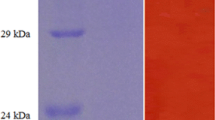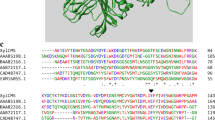Abstract
Two kinds of exoglucanase were purified from a marine Aspergillus niger. Catalytic ability of halophilic exoglucanase with a lower molecular weight and secondary structure change was analyzed at different salinities. Activity of the low molecular weight exoglucanase in 10% NaCl solution (w/v) was 1.69-fold higher of that in NaCl-free solution. Half-life time in 10% NaCl solution (w/v) was over 1.27-fold longer of that in NaCl-free solution. Free energy change of the low molecular weight exoglucanase denaturation, △G, in 10% NaCl solution (w/v) was 0.54 kJ/mol more than that in NaCl-free solution. Melt point in 10% NaCl solution (w/v), 52.01 °C, was 4.21 °C higher than that in NaCl-free solution, 47.80 °C. K m value, 0.179 mg/ml in 10% NaCl solution (w/v) was less 0.044 mg/ml than that, 0.224 mg/ml, in NaCl-free solution. High salinity made content of α-helix increased. Secondary structure change caused by high salinities improved exoglucanase thermostability and catalysis activity. The halophilic exoglucanase from a marine A. niger was valuable for hydrolyzing cellulose at high salinities.








Similar content being viewed by others
References
Sarkar, N., Ghosh, S. K., Bannerjee, S., & Aikat, K. (2012). Bioethanol production from agricultural wastes: an overview. Renewable Energy, 37, 19–27.
Dua, S. K., Sua, X., Yang, W. H., Wang, Y. Q., Kuang, M., Ma, L., Fang, D., & Zhou, D. Y. (2016). Enzymatic saccharification of high pressure assist-alkali pretreated cotton stalk and structural characterization. Carbohydrate Polymers., 140, 279–286.
Li, Y., Qi, B., Luo, J. Q., & Wan, Y. H. (2016). Effect of alkali lignins with different molecular weights from alkali pretreated rice straw hydrolyzate on enzymatic hydrolysis. Bioresource Technology., 200, 272–278.
Pang, Z. W., Lu, W., Zhang, H., Liang, Z. W., Liang, J. J., Du, L. W., Duan, C. J., & Feng, J. X. (2016). Butanol production employing fed-batch fermentation by Clostridium acetobutylicum GX01 using alkali-pretreated sugarcane bagasse hydrolysed by enzymes from Thermoascus aurantiacus QS. Bioresource. Technology., 212, 82–91.
Duff, S. J. B., & Murray, W. D. (1996). Bioconversion of forest products industry waste cellulosics to fuel ethanol: a review. Bioresource Technology, 55, 1–33.
Sun, W. C., Cheng, C. H., & Lee, W. C. (2008). Protein expression and enzymatic activity of cellulases produced by Trichoderma reesei rut C-30 on rice straw. Process Biochemistry, 43, 1083–1087.
Warren, R. A. J. (1996). Microbial hydrolysis of polysaccharides. Annual Review of Microbiology, 50, 183–212.
Howard, R. L., Abotsi, E., Jansen van Rensburg, E. L., & Howard, S. (2003). Lignocellulose biotechnology: issues of bioconversion and enzyme production. African Journal of Biotechnology, 2, 602–619.
Li, Q., He, Y. C., Xian, M., Jun, G., Xu, X., Yang, J. M., & Li, L. Z. (2009). Improving enzymatic hydrolysis of wheat straw using ionic liquid 1-ethyl-3-methylimidazolium diethyl phosphate pretreatment. Bioresource Technology, 100, 3570–3575.
Xu, F., Shi, Y. C., & Wang, D. (2012). Enhanced production of glucose and xylose with partial dissolution of corn stover in ionic liquid, 1-ethyl-3-methylimidazolium acetate. Bioresource Technology, 114, 720–724.
Turner, M. B., Spear, S. K., Huddleston, J. G., Holbrey, J. D., & Rogers, R. D. (2003). Ionic liquid salt-induced inactivation and unfolding of cellulase from Trichoderma reesei. Green Chemistry, 5, 443–444.
Zhao, H., Jones, C. L., Baker, G. A., Xia, S., Olubajo, O., & Person, V. N. (2009). Regenerating cellulose from ionic liquids for an accelerated enzymatic hydrolysis. Journal of Biotechnology, 139, 47–54.
Gunny, A. N., Arbain, D., Gumba, R. E., Jong, B. C., & Jamal, P. (2014). Potential halophilic cellulases for in situ enzymatic saccharification of ionic liquids pretreated lignocelluloses. Bioresource Technology, 155, 177–181.
Annamalai, N., Thavasi, R., Vijayalakshmi, S., & Balasubramanian, T. (2011). A novel thermostable and halostable carboxymethylcellulase from marine bacterium Bacillus licheniformis AU01. World Journal of Microbiology and Biotechnology, 27, 2111–2115.
Johnson, K. G., Lanthier, P. H., & Gochnauer, M. B. (1986). Studies of two strains of Actinopolyspora halophila, an extremely halophilic actinomycete. Archives of Microbiology, 143, 370–378.
Li, X., & Yu, H. Y. (2013). Characterization of a halostable endoglucanase with organic solvent-tolerant property from Haloarcula sp. G10. International Journal of Biological Macromolecules, 62, 101–106.
Xue, D. S., Chen, H. Y., Ren, Y. R., & Yao, S. J. (2012). Enhancing the activity and thermostability of thermostable β-glucosidase from a marine Aspergillus niger. Process Biochemistry, 47, 606–611.
Xue, D. S., Chen, H. Y., Lin, D. Q., Guan, Y. X., & Yao, S. J. (2012). Optimization of a natural medium for cellulase by a marine Aspergillus niger using response surface methodology. Applied Biochemistry and Biotechnology, 167, 1963–1972.
Hoefer Inc. (1994). Protein electrophoresis Applications Guide. San Francisco: Hoefer Scientific Instruments.
Miller, G. L. (1959). Use of dinitrosalicylic acid reagent for determination of reducing sugar. Analytical Chemistry, 31, 426–428.
Lineweaver, H., & Burk, D. (1934). The determination of enzyme dissociating constants. Journal of the American Chemical Society, 56, 658–666.
Siddiqui, K. S., Saqib, A. A. N., Rashid, M. H., & Rajoka, M. I. (1997). Thermostabilization of carboxymethyl-cellulase from Aspergillus niger by carboxyl group modification. Biotechnology Letters, 19, 325–329.
Karnchanatat, A., Petsom, A., Sangvanich, P., Piapukiew, J., Whalley, A. J. S., Reynolds, C. D., Gad, G. M., & Sihanonth, P. (2008). A novel thermostable endoglucanase from the wood-decaying fungus Daldinia eschscholzii (Ehrenb.:Fr.) Rehm. Enzyme and Microbial Technol., 42, 404–413.
Bok, J., Dienesh, A., & Yernool, D. (1998). Purification, characterization and molecular analysis of thermostable cellulases CelA and CelB from Thermotoga neapolitana. Applied and Environmental Microbiology, 64, 4774–4781.
Fabian, H., Naumann, D., Misselwitz, R., Ristau, O., Gerlach, D., & Welfle, H. (1992). Secondary structure of streptokinase in aqueous solution: a Fourier transform infrared spectroscopic study. Biochemistry, 31, 6532–6538.
Moroz, O. V., Maranta, M., Shaghasi, T., Harris, P. V., Wilson, K. S., & Davies, G. J. (2015). The three-dimensional structure of the cellobiohydrolase Cel7A from Aspergillus fumigatus at 1.5 resolution. Acta, Crystallogr. Sect. F, 71, 114.
Kim, D. W., Jeong, Y. K., Jang, Y. H., & Lee, J. K. (1994). Purification and characterization of endoglucanase and exoglucanase components from Trichoderma viride. Journal of Fermentation and Bioengineering., 7, 363–369.
Singh, A., Agrawal, A. K., Abidi, A. B., & Darmwal, N. S. (1990). Properties of exoglucanase from Aspergillus niger. Journal of General & Applied Microbiology., 36, 245–254.
Mahmood, R. T., Asad, M. J., Mehboob, N., Mushtaq, M., Gulfraz, M., Muhammad Asgher, M., Minhas, N. M., & Hadri, S. H. (2013). Production, purification, and characterization of exoglucanase by Aspergillus fumigatus. Applied Biochemistry and Biotechnology, 170, 895–908.
Tuka, K., Zverlov, V. V., Bumazkin, B. K., Velikodvorskaya, G. A., & Strongin, A. Y. (1990). Cloning and expression of Clostridium thermocellum genes coding for thermostable exoglucanases (cellobiohydrolases) in Escherichia coli cells. Biochemical and Biophysical Research Communications., 169, 1055–1060.
Xu, J. X., Xiong, P., & He, B. F. (2016). Advances in improving the performance of cellulase in ionic liquids for lignocellulose biorefinery. Bioresource Technology, 200, 961–970.
Danson, M. J., & Hough, D. W. (1997). The structural basis of protein halophilicity. Comparative Biochemistry and Physiology. Part A, Physiology, 117, 307–312.
Begemann, M. B., Mormile, M. R., Paul, V. G., & Vidt, D. J. (2011). Potential enhancement of biofuel production through enzymatic biomass degradation activity and biodiesel production by halophilic microorganisms. In A. Ventosa, A. Oren, & Y. Ma (Eds.), Halophiles and hypersaline environments current research and future trends (p. 345). Berlin: Springer-Verlag (Chapter 18).
Yu, H. Y., & Li, X. (2015). Alkali-stable cellulase from a halophilic isolate, Gracilibacillus sp. SK1 and its application in lignocellulosic saccharification for ethanol production. Biomass and Bioenergy., 81, 19–25.
Teeri, T. T., & Koivula, A. (1995). Cellulose degradation by native and engineered fungal cellulases. Carbohydr. Eur., 12(28–33115), 391–397.
Marangoni, A. G. (2003, ISBN: 0-471-15985-9). Enzyme kinetics a modern approach (pp. 146–150). NJ: Wiley.
Damodaran, S. (2006). Protein: denaturation. In Y. H. Hi (Ed.), Handbook of food science, technology and engineering. F L: CRC Press.
Oren, A. (2003). Halophilic microorganisms and their environments. Publishers: Kluwer Academic.
Mesbah, N. M., & Wiegel, J. (2005). Halophilic thermophiles: a novel group of extremophiles. In T. Satyanarayana & B. N. Johri (Eds.), Microbial diversity: Current perspectives and Potential Applications (pp. 91–118). New Delhi: I.K. Publishing House.
Karan, R., Capes, M. D., & Dassarma, S. (2012). Function and biotechnology of extremophilic enzymes in low water activity. Aquatic Biosystems, 8, 4–15.
Susi, H., & Michael, B. M. (1983). Protein structure by Fourier transform infrared spectroscopy: second derivative spectra. Biochemical and Biophysical Research Communications, 115(1), 391–397.
Torii, H., & Tasumi, M. (1992). Three-dimensional doorway-state theory for analyses of absorption bands of many-oscillator systems. The Journal of Chemical Physics, 97, 86–91.
Spassov, S., Beekes, M., & Naumann, D. (2006). Structural differences between TSEs strains investigated by FT-IR spectroscopy. Biochimica et Biophysica Acta, 1760, 1138–1149.
Kim, S. J., Joo, J. E., Jeon, S. D., Hyeon, J. E., Kim, S. W., Umc, Y. S., & Han, S. O. (2016). Enhanced thermostability of mesophilic endoglucanase Z with a high catalytic activity at active temperatures. International Journal of Biological Macromolecules., 86, 269–276.
Ortega, G., Diercks, T., & Millet, O. (2015). Halophilic protein adaptation results from synergistic residue-ion interactions in the folded and unfolded states. Chemistry & Biology, 22, 1597–1607.
Acknowledgement
This work was supported by the National Natural Science Foundation of China (31271928) and the Natural Science Foundation of Hubei Provincial Department of Education (Design of ethanol tolerant endoglucanase and mechanism of ethanol tolerance). Long yuan Liang was co-first author.
Author information
Authors and Affiliations
Corresponding author
Rights and permissions
About this article
Cite this article
Xue, Ds., Liang, Ly., Lin, Dq. et al. Thermal Inactivation Kinetics and Secondary Structure Change of a Low Molecular Weight Halostable Exoglucanase from a Marine Aspergillus niger at High Salinities. Appl Biochem Biotechnol 183, 1111–1125 (2017). https://doi.org/10.1007/s12010-017-2487-3
Received:
Accepted:
Published:
Issue Date:
DOI: https://doi.org/10.1007/s12010-017-2487-3




